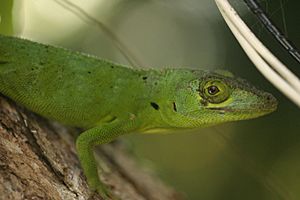Anolis cuvieri facts for kids
Quick facts for kids Anolis cuvieri |
|
|---|---|
 |
|
| Scientific classification | |
| Genus: |
Anolis
|
| Species: |
cuvieri
|
| Synonyms | |
The Anolis cuvieri is a type of lizard found only in Puerto Rico. People in Puerto Rico sometimes call it lagarto verde (green lizard) or lagarto chipojo. In English, it's known as the Puerto Rican giant anole or Cuvier's anole. You can often find this lizard in the Toro Negro State Forest.
Contents
What's in a Name?
The second part of its scientific name, cuvieri, honors a famous French naturalist named Georges Cuvier. A naturalist is someone who studies nature.
Meet the Puerto Rican Giant Anole
The Anolis cuvieri is quite a large lizard for an anole. It can grow up to 132 millimeters (about 5.2 inches) long from its snout to the base of its tail. It has a strong skull and long back legs. You might also notice a bumpy ridge of scales along its back.
Like most anoles, this species has special pads under its toes. These pads help it stick to vertical surfaces, like tree trunks. The lizard is mostly green. Some individuals might have faint light green stripes on their sides and back.
Colors and Patterns
Some large adult males have sky blue blotches on their heads. This blue color can spread to their neck and even down their spine. Females might have a light blue tint on their heads, but it doesn't spread as much.
The area around their eyes is usually bright yellow or yellow-green. Both male and female Puerto Rican giant anoles have a large flap of skin under their chin called a dewlap. In males, this dewlap is bright yellow and much bigger. Females have a light green dewlap with a blue-green top part and faint black stripes.
Growing Up: Color Changes
Young Anolis cuvieri lizards are different colors than adults. When they are young, both males and females are gray-brown or brown. They have brown stripes along their body and legs. As they get older, they slowly change to the green color of the adults.
There's also a rare type of adult A. cuvieri that stays brown. This brown type has black spots on its sides and neck. Its eye area is blotched with yellow. Both male and female lizards have a large crest (a raised part) on their tail. This crest is usually taller in males.
Where They Live
Anolis cuvieri belongs to a group of anoles called "crown giants." These are large lizards that live high up in the tops of tall trees. They don't often come down to the ground. You'll only find them in healthy forests that have many large trees.
They usually stay several meters above the ground. They prefer to live in palm trees, Ficus trees, and other big trees. These lizards move by jumping from branch to branch in the tree canopy. Their long back legs help them with this jumping lifestyle. They prefer wet forest areas, like cloud forests, and are rarely found in dry places.
What They Eat
Like all anoles, Anolis cuvieri mainly eats insects. They hunt for tree-dwelling insects such as large beetles and moths. This lizard is also an opportunist. This means it will eat whatever food it can find.
Its strong skull and powerful bite allow it to eat a wide range of prey. This includes other anoles, young lizards of its own kind, small birds, and even large snails. Sometimes, they will also eat fruit.
How They Behave
Both male and female Anolis cuvieri are very territorial and aggressive. This means they protect their space. Males are especially aggressive towards other males. They also act aggressively towards anything they see as a threat.
When a male sees an intruder in his territory, he will perform special displays. He will extend and pull back his dewlap. He will also do head bobs or pushups. This usually happens before the intruder gets too close. Often, this display is enough to scare the intruder away.
However, if the intruder doesn't leave, a fight might start. The males will lock jaws and bite each other's legs and body. They will keep fighting until one gives up and runs away, or becomes too tired to continue. Fights can sometimes be deadly if a lizard gets a serious injury, like a lost limb, that later gets infected.
If you try to handle this lizard, it might try to bite you. Its strong jaws can break the skin. It might also display its aggression if it sees a potential predator or someone trying to catch it. Like many reptiles, the mouth of this species can carry germs. So, if a bite breaks the skin, an infection could occur.
Threats and Conservation
The Anolis cuvieri faced threats in Puerto Rico because of deforestation (cutting down forests) and environmental degradation (damage to the environment). For a long time, it was only found in a few areas of healthy natural forest. However, its population seems to be stable now.
In the early 1900s, when a lot of forests were cut down in Puerto Rico, this species almost disappeared. People didn't see it for many years. They even worried it might be extinct. But after farming declined in Puerto Rico in the late 1950s, deforestation stopped. After that, the species made an amazing recovery. Even though it's still only found in certain places, it has become quite common in some of the remaining natural rainforests on the island.
Images for kids
Gallery






